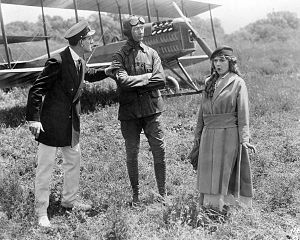Martin T
| Model T, Model TT | |
|---|---|

| |
| Role | Military trainer aircraft |
| National origin | United States |
| Manufacturer | Martin |
| Designer | Charles F. Willard |
| First flight | 1913 |
| Primary user | United States Army |
| Number built | 17 |
| Variants | Martin S |
The Martin T or TT was a training biplane produced in the United States in 1913 for military use.[1] It was a conventional, three-bay biplane with unstaggered wings of equal span. The pilot and instructor sat in tandem, open cockpits with dual controls. Fixed, taildragger undercarriage was fitted, which could be exchanged for a single pontoon under the fuselage and wingtip floats.[2]
Early examples were delivered to the Army without engines, so the Army could power them with engines salvaged from other aircraft, but later TTs came equipped with Curtiss, Hall-Scott, or Sturtevant engines.[3]
In 1915, a Model TT was piloted by Oscar Brindley to win the Curtiss Marine Trophy for the longest flight within 10 consecutive hours in one day, covering 444 mi (710 km).[3]
The Model T was the basis for the Martin S Hydro seaplane, with a lengthened fuselage, a greater span, and upper wing ailerons.
The first Martin T acquired, Signal Corps Number 31, was deployed to Texas in April 1915 as the Army massed around Brownsville in response to civil war in Mexico involving forces under Pancho Villa. On April 20, S.C. 31 became the first American military aircraft to be fired on by a hostile force. Although not hit by a machine gun firing at it from the Mexican side of the border, the returning pilot taxied it into a ditch and damaged it beyond repair.[4][5]
Variants
- Martin T
- Two-seat training biplane for the US Army, three built (S.C. 31-33)
- Martin TT
- Variant with Curtiss, Hall-Scott, or Sturtevant piston engines, 14 built (S.C. 37-38, 50-51, 54-55, 96-101, 330-331)
Operators
Specifications (TT)
Data from Holcomb[3]
General characteristics
- Crew: two - pilot and instructor
- Length: 26 ft 4 in (8.01 m)
- Wingspan: 38 ft 8 in (11.79 m)
- Height: 9 ft 4 in (2.85 m)
- Wing area: 379 sq ft (35.2 m2)
- Empty weight: 1,320 lb (600 kg)
- Gross weight: 1,720 lb (780 kg)
- Powerplant: 1 × Curtiss OX-2 , 90 hp (67 kW)
Performance
- Maximum speed: 96 mph (152 km/h, 83 kn)
- Service ceiling: 9,500 ft (2,900 m)
References
- ^ * Taylor, Michael J. H. (1989). Jane's Encyclopedia of Aviation. London: Studio Editions. ISBN 978-1851703241.
- ^ The Illustrated Encyclopedia of Aircraft, 2432
- ^ a b c Holcomb, Kevin. "Martin T.T." Holcomb's Aerodrome. Retrieved 2008-10-20.
- ^ Dan Heaton (June 6, 2012). "Combat Over Texas: America's First Combat Sortie Took Place April 20, 1915, in Brownsville, Texas". Texas Escapes online magazine. Retrieved August 25, 2012.
- ^ "Launching Site of First U.S. Army Warplane: Texas Historical Marker". Archived from the original on May 13, 2014. Retrieved August 25, 2012.
Further reading
- Elliot, Bryn (March–April 1997). "Bears in the Air: The US Air Police Perspective". Air Enthusiast. No. 68. pp. 46–51. ISSN 0143-5450.
- World Aircraft Information Files. London: Bright Star Publishing.
